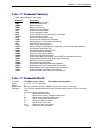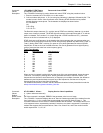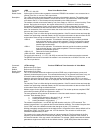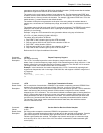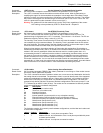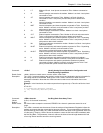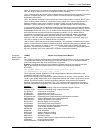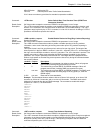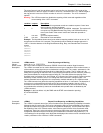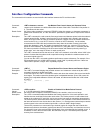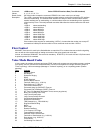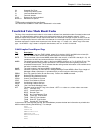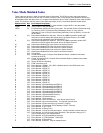
Chapter 6 – Voice Commands
SocketModem Global MT5634SMI Developer’s Guide 54
<cml> is used by the PC to select a compression method. The valid range of values is from 128–
256. The range of values from 0–127 is reserved for future standards.
<vsr> is used to select the modem voice sampling rate from the set of those supported. The unit of
measure is samples per second. See the +VSM=? command for the list of sampling rates
supported by the modem.
<scs> has different meanings in voice transmit and voice receive modes. In receive, the PC uses
<scs> to select greater amounts of compression activity; larger <scs> values mean that the PC
wants the modem to treat noisier conditions as silence. There is no unit of measure for this
parameter; it merely represents a number in a range. 0 disables modem silence compression.
In voice transmit mode, the PC signals the modem that the data stream was recorded with silence
compression by selecting a non-zero value from within the valid range (the same value as receive).
Unpredictable results can occur if you 1) enable silence compression for transmitting a voice data
stream that was not recorded with silence compression enabled, or 2) you disable silence
compression for transmitting a voice data stream that was recorded with silence compression
enabled. You can modify the silence expansion with the <sel> parameter. The range of valid
values is 0–255. The modem may limit silence compression sensitivity to a narrower range (e.g.,
120–128). A setting of <scs>=0 disables silence compression.
<sel> is used to modify the amount of silence expansion. This parameter represents the minimum
amount of silence that the modem will expand a period of silence that was previously deleted with a
non-zero <sel> parameter. A setting of <sel>=0 means the modem will not modify the silence
expansion. The valid range of values is ____ - ____ in 0.1second increments. The modem ignores
the <sel> parameter if the <scs> parameter is 0 (silence compression disabled).
Command: +VSM=? Report Voice Compression Method
Result Codes: OK
Description: The +VSM=? command reports several compression method identifiers in one of two ways: either
1) a compression method (for PCM coding) from the table below, or 2) a co-operative identifier
(non-PCM coding) used with other manufacturer's equipment.
Example: The following shows an inquiry about the modem support of compression and other
data. In this example, the modem reports that it supports two compression methods.
AT+VSM=?
128,"SIGNED PCM",12,0,(7200-8000,11025),(127-129),(0-50)
132,"ADPCM/AQ",2,40,(7200),(128),(0-50)
The compression method identifiers for PCM coding display the general classification of the
compression method in the form <cmid>.
Non-PCM coding reports the compression method identifiers in the form <cmid>/<author>, where
<cmid> is the general classification of the compression method and <author> is the source of the
method. The source <author> may be a proprietary method or it may reference a published
standard. Each field limit is 20 characters. The +VXT command starts a translation to or from a
particular manufacturer's proprietary voice data stream format to an unsigned (non-PCM) format.
Identifier Description
Signed PCM Linear PCM sampling using twos complement signed numbers
Unsigned PCM Linear PCM sampling using unsigned numbers
A-Log/Author Compression using a-law
U-Log/Author Compression using u-law
DPCM/Author Differential Pulse Coded Modulation
DPCMAQ/Author Differential Pulse Coded Modulation with Adaptive Quantizier
ADPCM/Author Adaptive Differential Pulse Coded Modulation
VSELP/Author Vector Sum Exited Linear Predictor
RELP/Author Residual Exited Linear Predictor
CELP/Author Code Book Exited Linear Predictor
CVSD/Author Continuously Variable Slope Delta Modulation
TDHS/Author Time Domain Harmonic Distortion
ADM/Author Adaptive Delta Modulation
DM/Author Delta Modulation
APC/Author Adaptive Predictive Coding
ATC/Author Adaptive Transform Coding
SBC/Author Sub-Band Coding
GSM/Author Regular Pulse Exitation Long-term Predictor (RPELTP)
LPC/Author Linear Predictive Coding
EAPDPCM/Author Embedded Bit ADPCM



